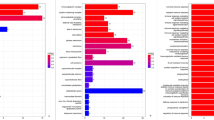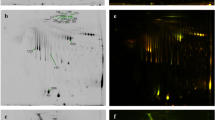Abstract
Purpose
The mechanisms underlying HBV intrauterine transmission remain unknown. In this study, we explored the mechanism of HBV intrauterine transmission by iTRAQ proteomics analysis.
Methods
iTRAQ technology was applied to perform comparative proteomics studies on six HBV+/+ neonates and six HBV+/− neonates whose mothers and fathers were HBsAg positive and paternal HBsAg negative, respectively. The data obtained from the mass spectrometer were analyzed using MASCOT (https://matrixscience.com) to qualitatively and quantitatively compare the differentially expressed proteins in the two groups. Gene Ontology and KEGG pathway analyses were performed to analyze the differentially expressed proteins. The expressions of HBV intrauterine transmission-related proteins in serum samples and corresponding placental tissues were further verified by immunohistochemistry and Western Blot. Then, the human trophoblast cell line (Swan71) infected with HBV was used to analyze the potential mechanisms of HBV intrauterine transmission under the mediation of differential proteins.
Results
A total of 35 differentially expressed proteins, including 17 up-regulated proteins and 18 down-regulated proteins, were identified by comparing serum protein expression levels in HBV+/+ and HBV+/− neonates. The differentially expressed proteins were mainly related to RAGE receptor binding, NF-kappa B transcription factor activity, innate immune response, defense response to bacterium, and the signaling pathway in pathogenic microorganism infection. The expressions of S100A8/9/12 in HBV+/+ maternal placenta tissue were significantly increased. The expressions of S100A8/9/12 proteins in Swan71 cells were significantly increased after HBV infection.
Conclusion
High expression of S100 proteins may be associated with the intrauterine-transplacental transmission of HBV.






Similar content being viewed by others
Availability of data and materials
The analyzed data sets generated during the study are available from the corresponding author on reasonable request.
References
Ott JJ, Stevens GA, Groeger J, Wiersma ST (2012) Global epidemiology of hepatitis B virus infection: new estimates of age-specific HBsAg seroprevalence and endemicity. Vaccine 30(12):2212–2219. https://doi.org/10.1016/j.vaccine.2011.12.116
Yonghao G, Jin X, Jun L, Pumei D, Ying Y, Xiuhong F, Yanyang Z, Wanshen G (2015) An epidemiological serosurvey of hepatitis B virus shows evidence of declining prevalence due to hepatitis B vaccination in central China. Int J Infect Dis IJID Off Publ Int Soc Infect Dis 40:75–80. https://doi.org/10.1016/j.ijid.2015.10.002
Visvanathan K, Dusheiko G, Giles M, Wong ML, Phung N, Walker S, Le S, Lim SG, Gane E, Ngu M, Hardikar W, Cowie B, Bowden S, Strasser S, Levy M, Sasaduesz J (2016) Managing HBV in pregnancy. Prevention, prophylaxis, treatment and follow-up: position paper produced by Australian, UK and New Zealand key opinion leaders. Gut 65(2):340–350. https://doi.org/10.1136/gutjnl-2015-310317
Liu SL, Dong Y, Zhang L, Li MW, Wo JE, Lu LW, Chen ZJ, Wang YZ, Ruan B (2009) Influence of HBV gene heterogeneity on the failure of immunization with HBV vaccines in eastern China. Adv Virol 154(3):437–443. https://doi.org/10.1007/s00705-009-0315-y
Han GR, Jiang HX, Yue X, Ding Y, Wang CM, Wang GJ, Yang YF (2015) Efficacy and safety of telbivudine treatment: an open-label, prospective study in pregnant women for the prevention of perinatal transmission of hepatitis B virus infection. J Viral Hepatitis 22(9):754–762. https://doi.org/10.1111/jvh.12379
Xu DZ, Yan YP, Zou S, Choi BC, Wang S, Liu P, Bai G, Wang X, Shi M, Wang X (2001) Role of placental tissues in the intrauterine transmission of hepatitis B virus. Am J Obstet Gynecol 185(4):981–987. https://doi.org/10.1067/mob.2001.117968
Bharadwaj A, Bydoun M, Holloway R, Waisman D (2013) Annexin A2 heterotetramer: structure and function. Int J Mol Sci 14(3):6259–6305. https://doi.org/10.3390/ijms14036259
Brandherm I, Disse J, Zeuschner D, Gerke V (2013) cAMP-induced secretion of endothelial von Willebrand factor is regulated by a phosphorylation/dephosphorylation switch in annexin A2. Blood 122(6):1042–1051. https://doi.org/10.1182/blood-2012-12-475251
Dziduszko A, Ozbun MA (2013) Annexin A2 and S100A10 regulate human papillomavirus type 16 entry and intracellular trafficking in human keratinocytes. J Virol 87(13):7502–7515. https://doi.org/10.1128/JVI.00519-13
Bode G, Luken A, Kerkhoff C, Roth J, Ludwig S, Nacken W (2008) Interaction between S100A8/A9 and annexin A6 is involved in the calcium-induced cell surface exposition of S100A8/A9. J Biol Chem 283(46):31776–31784. https://doi.org/10.1074/jbc.M803908200
Liu Y, Myrvang HK, Dekker LV (2015) Annexin A2 complexes with S100 proteins: structure, function and pharmacological manipulation. Br J Pharmacol 172(7):1664–1676. https://doi.org/10.1111/bph.12978
Streicher WW, Lopez MM, Makhatadze GI (2009) Annexin I and annexin II N-terminal peptides binding to S100 protein family members: specificity and thermodynamic characterization. Biochemistry 48(12):2788–2798. https://doi.org/10.1021/bi8019959
Muhammad A, Coopmans EC, Gatto F, Franck SE, Janssen J, van der Lely AJ, Hofland LJ, Neggers S (2019) Pasireotide responsiveness in acromegaly is mainly driven by somatostatin receptor subtype 2 expression. J Clin Endocrinol Metabol 104(3):915–924. https://doi.org/10.1210/jc.2018-01524
Rashid-Doubell F, Tannetta D, Redman CW, Sargent IL, Boyd CA, Linton EA (2007) Caveolin-1 and lipid rafts in confluent BeWo trophoblasts: evidence for Rock-1 association with caveolin-1. Placenta 28(2–3):139–151. https://doi.org/10.1016/j.placenta.2005.12.005
Xu DZ, Yan YP, Choi BC, Xu JQ, Men K, Zhang JX, Liu ZH, Wang FS (2002) Risk factors and mechanism of transplacental transmission of hepatitis B virus: a case-control study. J Med Virol 67(1):20–26. https://doi.org/10.1002/jmv.2187
Wei J, Xue S, Zhang J, Wang S, Wang B (2015) Study of the relationship in pregnant women between hepatitis B markers and a placenta positive for hepatitis B surface antigen. J Perinat Med 43(2):191–199. https://doi.org/10.1515/jpm-2014-0056
Bai X, Tian T, Wang P, Yang X, Wang Z, Dong M (2015) Potential roles of placental human beta-defensin-3 and apolipoprotein B mRNA-editing enzyme catalytic polypeptide 3G in prevention of intrauterine transmission of hepatitis B virus. J Med Virol 87(3):375–379. https://doi.org/10.1002/jmv.24072
Tian T, Sun D, Wang P, Wang H, Bai X, Yang X, Wang Z, Dong M (2015) Roles of Toll-like receptor 7 and 8 in prevention of intrauterine transmission of hepatitis B Virus. Cell Physiol Biochem Int J Exp Cell Physiol Biochem Pharmacol 37(2):445–453. https://doi.org/10.1159/000430367
Bai X, Yang H, Wan L, Wang P, Wang H, Yang X, Wang Z, Dong M (2017) Involvement of viperin in prevention of intrauterine transmission of hepatitis B virus. APMIS Acta Pathologica, Microbiologica, et Immunologica Scandinavica 125(2):170–175. https://doi.org/10.1111/apm.12630
Luciano-Montalvo C, Ciborowski P, Duan F, Gendelman HE, Meléndez LM (2008) Proteomic analyses associate cystatin B with restricted HIV-1 replication in placental macrophages. Placenta 29(12):1016–1023. https://doi.org/10.1016/j.placenta.2008.09.005
Santamaria-Kisiel L, Rintala-Dempsey AC, Shaw GS (2006) Calcium-dependent and -independent interactions of the S100 protein family. Biochem J 396(2):201–214. https://doi.org/10.1042/bj20060195
Donato R, Cannon BR, Sorci G, Riuzzi F, Hsu K, Weber DJ, Geczy CL (2013) Functions of S100 proteins. Curr Mol Med 13(1):24–57
Xu C, Chen H, Wang X, Gao J, Che Y, Li Y, Ding F, Luo A, Zhang S, Liu Z (2014) S100A14, a member of the EF-hand calcium-binding proteins, is overexpressed in breast cancer and acts as a modulator of HER2 signaling. J Biol Chem 289(2):827–837. https://doi.org/10.1074/jbc.M113.469718
Ezzikouri S, Ozawa M, Kohara M, Elmdaghri N, Benjelloun S, Tsukiyama-Kohara K (2014) Recent insights into hepatitis B virus-host interactions. J Med Virol 86(6):925–932. https://doi.org/10.1002/jmv.23916
Soldati T, Schliwa M (2006) Powering membrane traffic in endocytosis and recycling. Nat Rev Mol Cell Biol 7(12):897–908. https://doi.org/10.1038/nrm2060
Macovei A, Petrareanu C, Lazar C, Florian P, Branza-Nichita N (2013) Regulation of hepatitis B virus infection by Rab5, Rab7, and the endolysosomal compartment. J Virol 87(11):6415–6427. https://doi.org/10.1128/jvi.00393-13
Inoue J, Krueger EW, Chen J, Cao H, Ninomiya M, McNiven MA (2015) HBV secretion is regulated through the activation of endocytic and autophagic compartments mediated by Rab7 stimulation. J Cell Sci 128(9):1696–1706. https://doi.org/10.1242/jcs.158097
Funding
This work was supported by the National Natural Science Foundation of China [81671478]; the Health and Family Planning Commission of Zhejiang Province of China [2017KY904].
Author information
Authors and Affiliations
Contributions
Substantial contributions to conception and design: PZ, JW; data acquisition, data analysis and interpretation: LQ, XZ, XB, HW; drafting the article or critically revising it for important intellectual content: PZ, JW; final approval of the version to be published: All authors. Agreement to be accountable for all aspects of the work in ensuring that questions related to the accuracy or integrity of the work are appropriately investigated and resolved: all authors.
Corresponding authors
Ethics declarations
Conflict of interest
The authors declare no conflicts of interest.
Ethical approval and consent to participate
All procedures performed in studies involving human participants were in accordance with the ethical standards of the institutional and/or national research committee and with the 1964 Helsinki Declaration and its later amendments or comparable ethical standards. No animals are involved in this research.
Additional information
Publisher's Note
Springer Nature remains neutral with regard to jurisdictional claims in published maps and institutional affiliations.
Rights and permissions
About this article
Cite this article
Zhao, P., Wen, J., Qian, L. et al. Expression of S100 proteins is associated with HBV intrauterine transmission. Arch Gynecol Obstet 302, 1389–1399 (2020). https://doi.org/10.1007/s00404-020-05753-6
Received:
Accepted:
Published:
Issue Date:
DOI: https://doi.org/10.1007/s00404-020-05753-6




